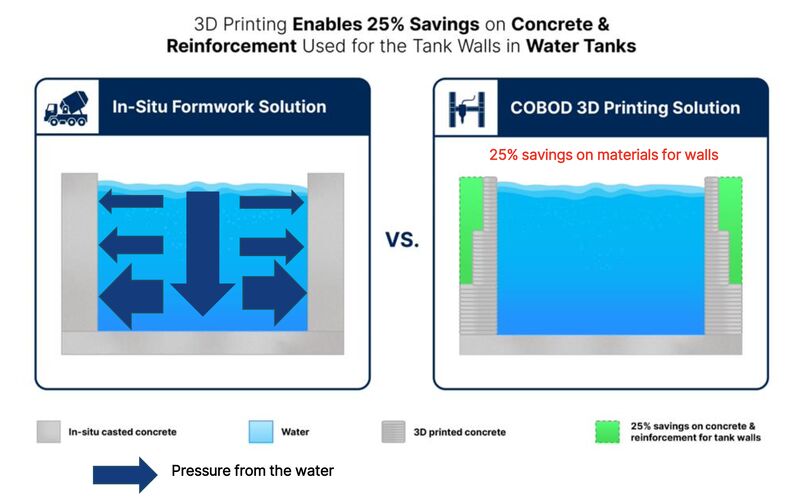In a previous article, “Concrete Dreams: Let’s Print Money, Not Houses,” we discussed how the spotlight on 3D printing homes might be misplaced. Bollards, pedestrian bridges, and concrete tanks could present much better business opportunities. The specific shape of these objects, as well as the timing and location of the 3D printing, are crucial. Additionally, the 3D printed concrete constitutes a larger portion of the overall object compared to a house, where components like tiles, toilets, and wiring must still be installed.
These types of concrete elements, which include planters and culverts, are produced in the millions and represent billions of dollars in annual revenue. Despite some innovation in artificial reefs, stairs, and planters, there is unfortunately little development in 3D printed concrete elements.
So, imagine my unadulterated joy when we learned of a LinkedIn post by COBOD Founder Henrik Lund-Nielsen, highlighting advancements in 3D printing concrete tanks. He reported that the Kuwaiti firm Abyan Building Construction Company has achieved a 25% savings in materials for the tank walls using COBOD’s concrete 3D printing technology.
¨The key to this efficiency lies in 3D printing’s unique design freedom. This optimization was possible by the design flexibility of 3D printing, which allowed for the optimization of the water tanks’ wall designs, by reducing the thickness of the walls at the middle and upper part as the pressure on the walls are much smaller here than on the bottom,” Lund-Nielsen said of the new product. “The tanks were printed with real and low cost concrete using the D.fab solution and equipment developed by CEMEX and COBOD International. The concrete further contained macro fibers (0,93%) for the reinforcement of the walls, removing the need for any hard reinforcement of the wall. The tanks were printed in 5 days, which should be compared to that app. 3 weeks of work would have been needed just for the preparation of the formwork if a traditional in situ cast solution had been used.¨
Think of the global implications if we could save 10% of the total material used in all grain, water, and other tanks. Extend this thought to a broader range of structures, including garages, railroad ties, silos, barriers, and pylons—the environmental and cost impacts would be enormous. A notable development in this area is the addition of macro fibers, polymer fibers that enhance the durability and strength of concrete structures. In many cases, the integration of these fibers into the mix could replace steel reinforcement, potentially saving time, especially as improvements might be seen in print speed, adhesion, and cracking behavior. While we’re not suggesting that this innovation alone could lead to the construction of mega multi-story buildings, it could feasibly facilitate the easy construction of meters-high industrial structures.
Design optimization is clearly within 3D printing’s wheelhouse, and the implications of reducing wall thickness across a structure mean that designs could be significantly optimized. The five-day print time also suggests that this could become a highly lucrative business for contractors. Concrete tanks, which could store natural gas or water, are often complex and expensive structures. Additionally, these structures frequently serve remote areas, such as engineering outposts, mines, or oilfields, where they may also be time-sensitive.
This development is quite a coup for Abyan Building Construction Company, which is a COBOD distributor and operator. The firm’s General Manager, Shade Al Hariri, has extensive experience in civil engineering within the region, while CEO Dr. Ahmad Al Naseem is an expert in finite element analysis (FEA) and a professor. This combination of digital engineering expertise and in-field experience seems ideal for deploying a new 3D printing construction solution. I believe this could become an incredibly valuable application in automated construction. Given the sheer number of concrete elements and the vast quantity of tanks required globally, this could evolve into a sizable business in the coming years.
Subscribe to Our Email Newsletter
Stay up-to-date on all the latest news from the 3D printing industry and receive information and offers from third party vendors.
Print Services
Upload your 3D Models and get them printed quickly and efficiently.
You May Also Like
Johns Hopkins University Researchers Develop HyFAM Technology
Two scientists from Johns Hopkins University, Nathan C. Brown and Jochen Mueller, have developed a hybrid manufacturing technology they call HyFam, or Hybrid Formative Additive Manufacturing. Their work on this technology...
3D Printing G-Code Gets an Upgrade: T-Code
Good old G-Code still manages many 3D printers, great and small. Just like the STL, it’s a standard that enables collaboration while also holding the additive manufacturing (AM) industry back....
AM Rewind: The Biggest News and Trends of 2024
After a sluggish 2023, driven by persistent inflation and geopolitical tensions, 2024 has seen some recovery. Economic growth climbed from about 2.8 percent in 2023 to a modest 3.2 percent...
Metal Wire 3D Printer OEM ValCUN Announces Plans for 2025 Expansion
ValCUN, a Belgian original equipment manufacturer (OEM) of wire-based metal additive manufacturing (AM) hardware, has announced that the company has entered the next phase of its growth trajectory, making key...


































